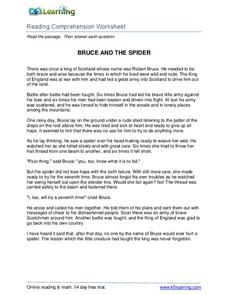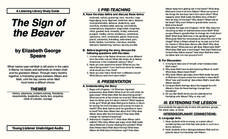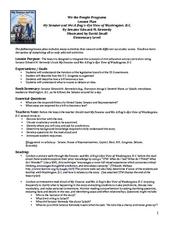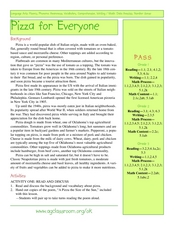K5 Learning
Bruce and the Spider
After reading the story of, Bruce and the Spider, scholars answer four short answer questions to boost comprehension skills.
Teacher's Corner
Is There a Wocket in my Pocket?
Accompany Dr. Seuss' Is There a Wocket in my Pocket? with this graphic organizer. Young readers make inferences about why the main character has certain feelings towards the creatures found in the story.
Grammar Net
For and Since
Fill in the blanks with a worksheet that focuses on for and since. As kids read 20 time-related phrases, they decide whether to use for, since, or no reply.
Do2Learn
Sequencing Chart
Take note of events in a story with this organizer. Learners write down the who, what, where, and when, writing down four events in the order that they occur.
Scholastic
So That's the Reason!
Make sure your pupils can hit the target when analyzing cause and effect by practicing with this worksheet. On each arrow, pupils write a cause of an event in a story, and on each bullseye, they write the effect.
Curated OER
Hatchet: Multicultural Strategy
Sometimes it's easier to read one part of a novel when focusing on discussion points. Partners work together to read a few paragraphs of Chapter 5 from Gary Paulsen's Hatchet and discuss the plot and theme of the book.
Curated OER
Monster: Guilty or Not Guilty
Is Steve Harmon innocent or guilty? Examine the evidence with a learning exercise based on Monster by Walter Dean Myers. As kids read the book, they note particular passages that they believe indicate whether or not Steve committed...
Curated OER
Out of the Dust: Questioning Strategies
Bloom's Taxonomy is a great way to address the many levels of comprehension. With explanations and examples of each level, you can create questions that focus on knowledge, comprehension, application, analysis, synthesis, and evaluation.
K12 Reader
Prime or Composite?
Prime numbers? Composite numbers? Prime factorization? After reading a short article about factors and prime and composite numbers, kids answer a series of comprehension questions based on the text.
Listening Library
The Sign of the Beaver
Extend a class reading of the novel The Sign of the Beaver across all subject areas with this literature unit guide. From basic discussion questions and writing prompts, to a research project about tracking animals, this...
Curated OER
The Swiss Family Robinson Teacher's Notes
Guide young readers through the classic novel The Swiss Family Robinson with this collection of activities and worksheets. From basic spelling and grammar practice, to reading comprehension skills, this resource will enhance...
Polk Bros Foundation
I Can Identify/Infer Motive
Why do people and characters act as they do? Require your class figure out the motivation of two people or characters they read about in a given text. In the short charts, pupils note down who, what they do, and why they do it. After...
Polk Bros Foundation
I Can Sequence Important Events
After reading any short informational or fictional text, ask your class to analyze the important events. They note down three important events on a short timeline, describing the events with either words or drawings. After this, pupils...
Polk Bros Foundation
I Can Compare and Contrast
Work with your class to fill out this Venn diagram. Pupils can compare and contrast any two things and then write a short paragraph about the relationship demonstrated in their diagram.
Recorded Books
Teacher's Guide: The Pinballs
Dive your class into the novel The Pinballs by Betsy Byars with the support of this reading guide. Including short answer questions, a multiple choice comprehension quiz, and extension activities, a variety of materials are...
PB Works
George Washington’s Socks: Short-Answer Questions Chapters 1-9
Build a literature unit around the book George Washington's Socks with this series of short answer questions. Broken up in two- and three-chapter increments, these reading comprehension questions allow young readers to demonstrate...
Curated OER
Where the Red Fern Grows Chapter 12-13 Worksheet
Ask your class to go back into the text to find the answers to these nine short answer questions that focus on a chunk of Wilson Rawls' novel. The questions require pupils to recall plot points and think about why certain events happened...
Curated OER
Where the Red Fern Grows Chapter 16-17
Find out how much your class understood of the listed chapters of Wilson Rawls' novel. Class members respond to eight plot and character questions before looking closely at an instance of personification from the text. The resource is...
Curated OER
Where the Red Fern Grows Chapter 19-20
Take a look at the final chapters of Wilson Rawls' much-loved novel. Class members respond to several plot-based questions and then consider the red fern as a symbol. The worksheet is part of a series that includes every chapter except...
Curated OER
A Poem's Theme
Show young poets how to use the main idea and voice to determine the theme of a poem. Model the steps using Listen Children. Lucille Clifton’s This Morning provides guided practice. Finally, class members use Nikki Giovanni’s...
Curated OER
My Senator and Me: A Dog's-Eye View of Washington, D.C.
Although this legislative process lesson is designed to accompany a specific text, it is valuable independently. Young learners participate in a picture walk (worksheet included) through My Senator and Me: A Dog's-Eye View...
Curated OER
Pizza for Everyone
Pizza is the inspiration for the cross-curricular lesson detailed here. Start out with a poem about pizza and move into a discussion about balanced eating. To close the language arts portion of the lesson, ask your pupils to write...
Curated OER
Don't Fence Me In
Ensure that your class has a well-rounded understanding of new inventions, in this case barbed wired. Class members, after researching the history and development of barbed wire, assess its impact on cattle and the development of the...
Alabama Learning Exchange
Investigating the Weather
Learners study, record, and predict weather. They work in groups to create a weather word wall, research and make a barometer, and create a video about weather. They use the Internet to research weather.

























